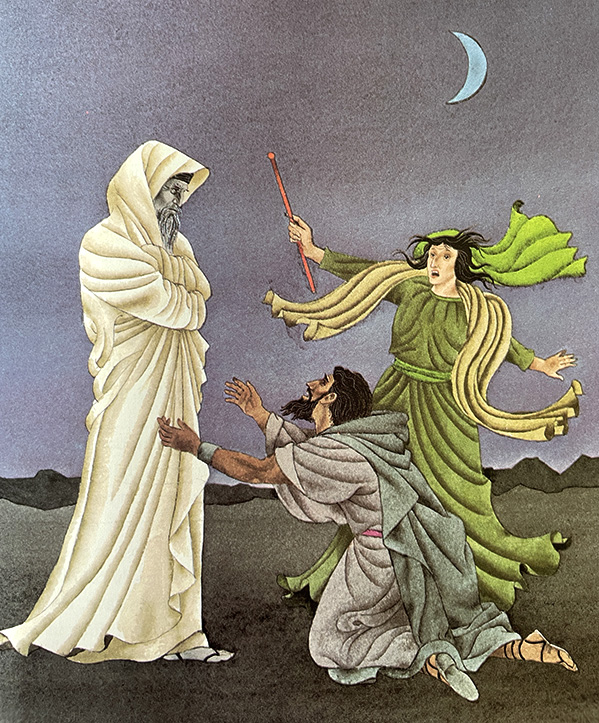Channeling
Channeling, a form of mediumship, is the ability to connect or communicate with a spiritual realm beyond our physical world, often for purposes of divination. This most commonly involves communing with the spirits of the dead as a form of necromancy. Other popular subjects for channeling include the Ascended Masters.
History
Attempts to communicate with the dead and other living human beings, aka spirits, have been documented back to early human history, such as the Biblical account of the Witch of Endor.
Throughout Antiquity, oracle were thought to be portals through which the gods spoke directly to people. In this sense, they were different from seers (manteis, μάντεις) who interpreted signs sent by the gods through bird signs, animal entrails, and other various methods.
At the Oracle of Amun at the Siwa Oasis, Alexander the Great spoke with a priest who directly channeled the Egyptian god Amun-Ra to ask if he was the son of Zeus.
Many cultures continue to employ a shaman as a designated person responsible for contacting the spirit world and relaying messages to and from the dead or other non-human entities.
Modern history
In the 1860s and 1870s, trance mediums who channeled spirits of the dead became very popular; this allowed female adherents, many who had strong interests in social justice, to speak in public in an era where doing so went against existing social norms. Trance speakers believed that entering a trance gave them access to the spirits and, through them, to clairvoyant knowledge inaccessible in the waking world.
Throughout the late 1800s and early 1900s, many channelers were exposed as frauds.
The channeler
A person who channels is known as a "trance medium" or a "conduit." Depending on the individual, this person is able to access any number of unseen portals, including the spiritual realm, metaphysical energy, or spiritual entity, or vice versa.
A central, but often overlooked, element of the phenomenon was an emphasis on "spirit," and in particular participants' desire for a relationship with spirit. Many practitioners of channeling describe themselves as "workers for spirit," expressing a desire to help people learn about spirit. Channelers often call upon this spirit to assist them in everyday situations, for instance, to ease the traffic flow on their way to work.
Ascended Masters
New Age literature often refers to benevolent non-human spirit-beings who are interested in humanity's spiritual development; these are variously referred to as angels, Ascended Masters, guardian angels, personal guides, teachers, and contacts.
The figure of Jesus Christ is often mentioned within esoteric literature as a mediating principle between divinity and humanity, as well as an exemplar of a spiritually advanced human being.
Methods
When a medium enters a state of trance, they can act as a channel of information from sources other than their normal selves.
In the later half of the 20th century, Western mediumship developed in two different ways. One type involves clairaudience, in which the medium is said to hear spirits and relay what they hear to their clients. The other is a form of channeling in which the channeler seemingly goes into a trance, and purports to leave their body allowing a spirit entity to borrow it and then speak through them. When in a trance the medium appears to enter into a cataleptic state, although modern channelers may not.
Some channelers open the eyes when channeling, and remain able to walk and behave normally. The rhythm and the intonation of the voice may also change completely.
Shamanism
In many cultures, shamans enter a trance through the use of psychoactive substances called "entheogens." These are drugs such as peyote, psilocybin, uncured tobacco, cannabis, ayahuasca, or LSD used in a ritualized context.
Practitioners of the Afro-Brazilian religion Candomblé channel various spirits during their rituals, deliberately becoming possessed by specific saint-like entities called orixá.
Types
Hanegraaff described channeling as a form of "articulated revelation" and identified four forms:
- trance channeling
- automatisms
- clairaudient channeling
- open channeling
Belief
For many New Agers, these channeled messages rival the scriptures of the main world religions as sources of spiritual authority, although often New Agers describe historical religious revelations as forms of "channeling" as well, thus attempting to legitimate and authenticate their own contemporary practices.
Although the concept of channeling from discarnate spirit entities has links to Spiritualism and psychical research, the New Age does not feature Spiritualism's emphasis on proving the existence of life after death, nor psychical research's focus of testing mediums for consistency.
Academic examination
The academic Suzanne Riordan examined a variety of these New Age channeled messages, noting that they typically "echoed each other in tone and content," offering an analysis of the human condition and giving instructions or advice for how humanity can discover its true destiny.
Scientists who study anomalistic psychology consider mediumship to be the result of fraud and psychological factors. Research from psychology for over a hundred years suggests that where there is not fraud, mediumship and Spiritualist practices can be explained by hypnotism, magical thinking, and suggestion.
Famous channelers
Rose Edith Kelly, wife of the English occultist and ceremonial magician Aleister Crowley channeled the voice of a non-physical entity named Aiwass during their honeymoon in Cairo, Egypt. These revelations led to the creation of the Thelema religion.
Dion Fortune was a British occultist, ceremonial magician, novelist and author. She was a co-founder of the Fraternity of the Inner Light, which promulgated teachings of the channeled Ascended Masters.
Hélène Smith who claimed to have channeled communications with people from Mars.
Another channeler in the early 1900s was Edgar Cayce, who said that he was able to channel his higher self while in a trance-like state.

